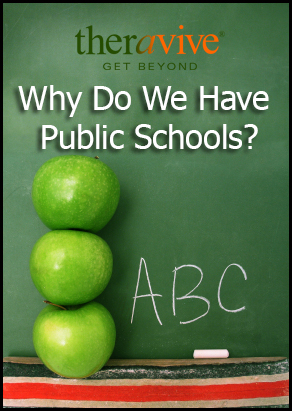 Ever wonder why you were forced to go to school as a kid? Wouldn’t it have just been easier to just stay at home and be taught by Mom or Dad while eating a peanut butter and jelly sandwich? What’s wrong with that? Apparently, a lot, according to compulsory education laws. Public compulsory education in the United States has its roots in the Prussian model of education, which was created for the purpose of teaching obedience in children.
Ever wonder why you were forced to go to school as a kid? Wouldn’t it have just been easier to just stay at home and be taught by Mom or Dad while eating a peanut butter and jelly sandwich? What’s wrong with that? Apparently, a lot, according to compulsory education laws. Public compulsory education in the United States has its roots in the Prussian model of education, which was created for the purpose of teaching obedience in children.
Education - an early history
Early forms of educational systems have been detected as far back as ancient Egypt. The first culture to really create a system of notable education was in Judea, where they were adamant about education, regardless of class. Elementary schools were established for boys and those who showed some brightness continued learning in the Synagogue. In ancient Greece and Rome, education was meant to create citizens ready for life in society. Rome wanted to create good orators, so there was a strong emphasis on Latin, literature and discipline. [1]
Education in The Middle Ages
The Middle Ages were dark times for education in Europe, and if it had not been for the church, education may have been lost completely. In contrast to early schools, medieval schools were non-graded, meaning all ages were taught together. They were cold, dreary places, really intended to create clergymen. In the 1400’s in the Americas, it was the Aztecs who were actually the first civilization to create a recognized compulsory education system for children of all classes. The Aztec Empire lasted from 1428 until 1521, until their defeat by the Spaniards. The system did not take root.
 The Renaissance and Reformation
The Renaissance and Reformation
The Renaissance in Europe saw major conceptual changes to education. For the first time, education was seen as a happy experience, not the disciplined, dreary experience of the past. More subjects were added to the curriculum as well, truly creating a well rounded education in letters and science. This “happy” idea of teaching did not last long.
The real and lasting changes in education began with the Reformation in Germany. School once again became a discipline. The new religion of Protestantism wanted to defend their faith so everything pagan was removed from the curriculum and once again emphasis was on drilling the Greek and Latin languages. The innovation at the time of the Reformation was the introduction of vernacular schools, that is, local schools where poor children could learn reading, writing, and religion in their dialect. Martin Luther really advocated for compulsory education in 1524 in Germany and Strasbourg passed legislation accordingly in 1598. This was followed shortly thereafter by the School Establishment Act in Scotland in 1616, which was an early form of public schooling in that it mandated that parishes with the means to pay for a school did so. [2]
Frederick the Great of Prussia
It was in 1763 that public school was changed forever, as Frederick the Great of Prussia, a country that used to exist between what is now Germany and Poland, introduced a centrally controlled compulsory system of education. The concept of the final exam was implemented in 1788 and was required to continue on into the professional world. Additionally, in 1810, Prussia introduced teaching standard certificates, which raised the level of teaching. Although attendance was supposed to be mandatory, it was not actually enforced by law until 1840 in Austria.His tax-funded education system was an eight year course of mandatory schooling. It is said that the King of Prussia had political need to create such schools, as he was trying to steer influence away from the increasingly powerful aristocracy and back to the King. In some ways, the schools were created to teach children to do the will of the King by not only teaching reading, writing and arithmetic, but duty, ethics and obedience. [3]
The Prussian Model and the United States
Frederick the Great’s model of education quickly gained a lot of traction, as leaders from many nations flocked to adapt it. In 1790, Pennsylvania called for free education for poor children, assuming that richer parents could pay for their child’s education and in 1805 New York followed similarly, by providing educations for poorer children. By 1870, all states had free elementary schools. [4]
In 1837, Horace Mann became head of the newly formed Massachusetts Board of Education. In 1848, Massachusetts created a reform school for children who refused to go to public school and in 1851 it also created the first compulsory education law. Mann based his educational system ideas on the Prussian model and called for the same content in education. Schools had been largely made up of classrooms of groups of students of all ages. It was Mann who took the idea of age grading from the Prussians and put it to use in the United States. This model spread to all the states and in 1917, Mississippi became the last state to require education. By 1918, every state required that children finish elementary school. [5]
For the next century, public school in the United States continued to expand and evolve into the system we currently know today.
_______________________________________________________________________________________________________
[1] [“The History of Education” Edited By: Robert Guisepi http://history-world.org/history_of_education.htm]
[2] [“Compulsory Education” http://en.wikipedia.org/wiki/Compulsory_education ]
[3] [“ Prussian education system” http://en.wikipedia.org/wiki/Prussian_education_system]
[4] [“Historical Timeline Of Public Education In The US” http://www.arc.org/content/view/100/217/]
[5] [History of education in the United States”
http://en.wikipedia.org/wiki/History_of_education_in_the_United_States#Colonial_era]
Christie Hunter is registered clinical counselor in British Columbia and co-founder of Theravive. She is a certified management accountant. She has a masters of arts in counseling psychology from Liberty University with specialty in marriage and family and a post-graduate specialty in trauma resolution. In 2007 she started Theravive with her husband in order to help make mental health care easily attainable and nonthreatening. She has a passion for gifted children and their education. You can reach Christie at 360-350-8627 or write her at christie - at - theravive.com.